Space
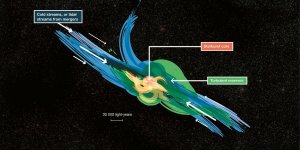
ALMA has been used to detect turbulent reservoirs of cold gas surrounding distant starburst galaxies. »
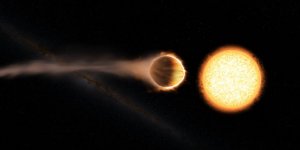
Scientists have discovered the strongest evidence to date for a stratosphere on a planet outside our solar system, or exoplanet. »
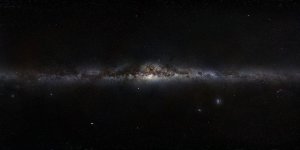
New research suggests up to half the matter in the Milky Way – including the atoms that make up all of us – could have come from outside our own galaxy, much more than scientists previously thought. »

NASA scientists have definitively detected the chemical acrylonitrile in the atmosphere of Saturn’s moon Titan, a place that has long intrigued scientists investigating the chemical precursors of life. »

Using new observations from ESO’s VLT Survey Telescope, astronomers have discovered three different populations of young stars within the Orion Nebula Cluster. »

Images of Jupiter’s Great Red Spot reveal a tangle of dark, veinous clouds weaving their way through a massive crimson oval. »

Astronomers at the University of Cambridge in England announced the discovery of a dwarf star, known as EBLM J0555-57Ab, which is slightly bigger than Saturn and smaller than Jupiter. It was found using data from an array of automated telescopes called the Wide Angle Search for Planets. »

NASA has achieved a significant milestone in its effort to make supersonic passenger jet travel over land a real possibility by completing the preliminary design review (PDR) of its Quiet Supersonic Transport or QueSST aircraft design. »

Arp 299 is a system located about 140 million light years from Earth. It contains two galaxies that are merging, creating a partially blended mix of stars from each galaxy in the process. »

By combining the power of a "natural lens" in space with the capability of NASA's Hubble Space Telescope, astronomers made a surprising discovery. »

NASA’s Kepler space telescope team has released a mission catalog of planet candidates that introduces 219 new planet candidates, 10 of which are near-Earth size and orbiting in their star's habitable zone, which is the range of distance from a star where liquid water could pool on the surface of a rocky planet. »

A new study suggests that most global climate models may underestimate the amount of rain that will fall in Earth’s tropical regions as our planet continues to warm. »
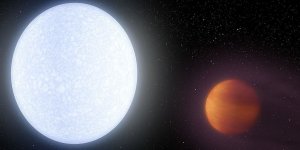
Astronomers at the Ohio State University, Columbus, revealed the discovery of an exoplanet, named KELT-9b and according to the university's astronomy professor Scott Gaudi, it is "the hottest gas giant planet that has ever been discovered". »
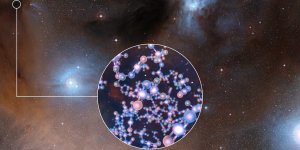
ALMA has observed stars like the Sun at a very early stage in their formation and found traces of methyl isocyanate — a chemical building block of life. »
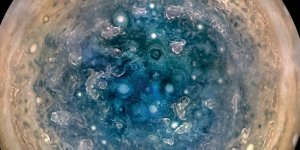
Early science results from NASA’s Juno mission to Jupiter portray the largest planet in our solar system as a complex, gigantic, turbulent world, with Earth-sized polar cyclones. »

A team of astronomers discovered a new kind of galaxy which, although extremely old -- formed less than a billion years after the Big Bang -- creates stars more than a hundred times faster than our own Milky Way. »

Scientists using NASA's Kepler Space Telescope identified a regular pattern in the orbits of the planets in the TRAPPIST-1 system that confirmed suspected details about the orbit of its outermost and least understood planet, TRAPPIST-1h. »

Heavy rain shaped the Martian landscape billions of years ago, according to a new study. »

A team of scientists led by Ian Boutle at the University of Exeter have created successful simulations of two possible atmospheres of Proxima B, an exoplanet orbiting Proxima Centauri, one a simple atmosphere of nitrogen tinged with carbon dioxide and another an Earth-like mix of gases. »

As NASA's Cassini spacecraft prepares to shoot the narrow gap between Saturn and its rings for the second time in its Grand Finale, Cassini engineers are delighted, while ring scientists are puzzled, that the region appears to be relatively dust-free. »

Scientists have discovered a new planet with the mass of Earth, orbiting its star at the same distance that we orbit our sun. The planet is likely far too cold to be habitable for life as we know it, however, because its star is so faint. »

NASA's Cassini spacecraft is back in contact with Earth after its successful first-ever dive through the narrow gap between the planet Saturn and its rings on April 26, 2017. »

With two suns in its sky, Luke Skywalker's home planet Tatooine in "Star Wars" looks like a parched, sandy desert world. »

After training a network of telescopes stretching from Hawaii to Antarctica to Spain at the heart of our galaxy for five nights running, astronomers said Wednesday they may have snapped the first-ever picture of a black hole. »

Mars has electrically charged metal atoms (ions) high in its atmosphere, according to new results from NASA's MAVEN spacecraft. »

Stellar explosions are most often associated with supernovae, the spectacular deaths of stars. But new ALMA observations provide insights into explosions at the other end of the stellar life cycle, star birth. »

Astronomers captured a series of dramatic images as they explored the firework-like debris from the birth of a group of massive stars, demonstrating that star formation can be a violent and explosive process too. »

An international team of astronomers has identified a record breaking brown dwarf (a star too small for nuclear fusion) with the 'purest' composition and the highest mass yet known. »

New NASA research reveals that the giant Martian volcano Arsia Mons produced one new lava flow at its summit every 1 to 3 million years during the final peak of activity. »

Mars may have had Saturn-like rings in the past and may have them again, a new study suggests. »

Saturn has rings, but it's possible that one of our closest neighbors also had rings at one point and may have them again someday. »

New observations indicate that massive, star-forming galaxies during the peak epoch of galaxy formation, 10 billion years ago, were dominated by baryonic or “normal” matter. »

A new study reports that the south polar region of Saturn's icy moon Enceladus is warmer than expected just a few feet below its icy surface. »

Astronomers have found a star that whips around a black hole about twice an hour. »

On Feb. 22, astronomers announced that the ultra-cool dwarf star, TRAPPIST-1, hosts a total of seven Earth-size planets that are likely rocky, a discovery made by NASA's Spitzer Space Telescope in combination with ground-based telescopes. »